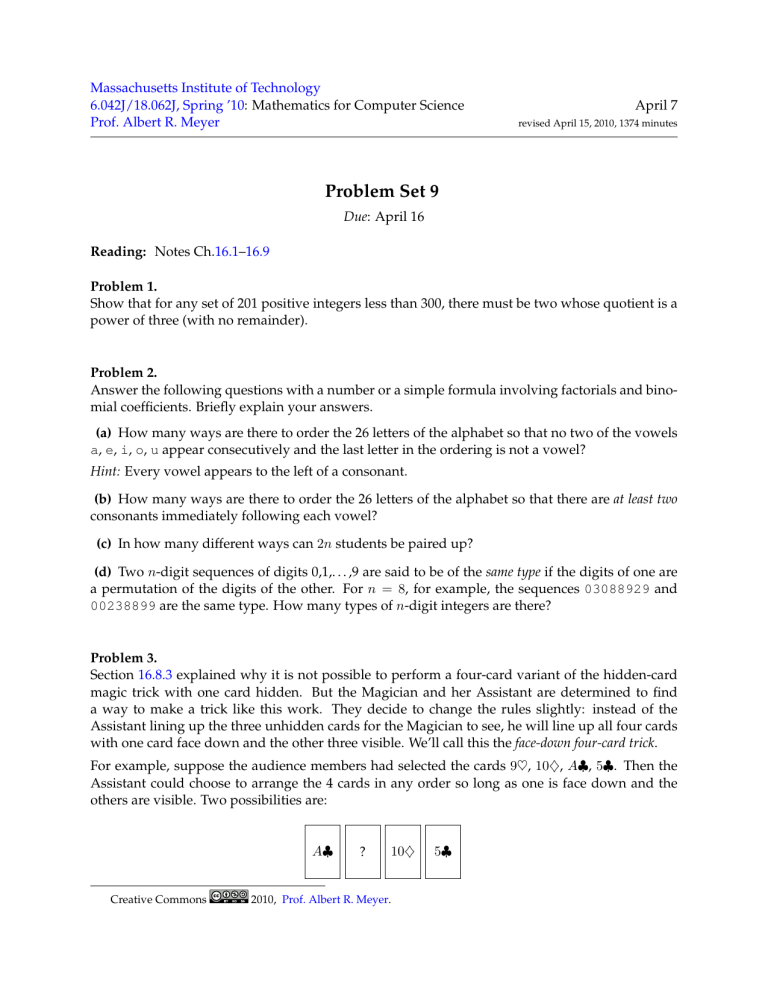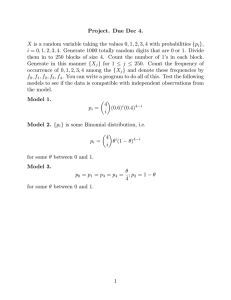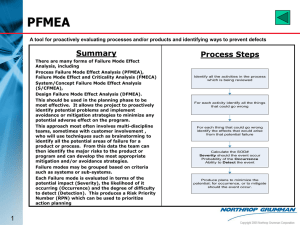Problem

Massachusetts Institute of Technology
6.042J/18.062J, Spring ’10 : Mathematics for Computer Science
Prof. Albert R. Meyer
April 7 revised April 15, 2010, 1374 minutes
Problem Set 9
Due : April 16
Reading: Notes Ch.
16.1
– 16.9
Problem 1.
Show that for any set of 201 positive integers less than 300, there must be two whose quotient is a power of three (with no remainder).
Problem 2.
Answer the following questions with a number or a simple formula involving factorials and bino mial coefficients. Briefly explain your answers.
(a) How many ways are there to order the 26 letters of the alphabet so that no two of the vowels a , e , i , o , u appear consecutively and the last letter in the ordering is not a vowel?
Hint: Every vowel appears to the left of a consonant.
(b) How many ways are there to order the 26 letters of the alphabet so that there are at least two consonants immediately following each vowel?
(c) In how many different ways can 2 n students be paired up?
(d) Two n -digit sequences of digits 0,1,. . . ,9 are said to be of the same type if the digits of one are a permutation of the digits of the other. For n = 8 , for example, the sequences 03088929 and
00238899 are the same type. How many types of n -digit integers are there?
Problem 3.
Section 16.8.3 explained why it is not possible to perform a four-card variant of the hidden-card magic trick with one card hidden. But the Magician and her Assistant are determined to find a way to make a trick like this work. They decide to change the rules slightly: instead of the
Assistant lining up the three unhidden cards for the Magician to see, he will line up all four cards with one card face down and the other three visible. We’ll call this the face-down four-card trick .
For example, suppose the audience members had selected the cards 9 ♥ , 10 ♦ , A ♣ , 5 ♣ . Then the
Assistant could choose to arrange the 4 cards in any order so long as one is face down and the others are visible. Two possibilities are:
Creative Commons
A ♣ ?
10 ♦ 5 ♣
2010, Prof. Albert R. Meyer .
2 Problem Set 9
? 5 ♣ 9 ♥ 10 ♦
(a) Explain why there must be a bipartite matching which will in theory allow the Magician and
Assistant to perform the face-down four-card trick.
(b) There is actually a simple way to perform the face-down four-card trick.
Case 1 . there are two cards with the same suit : Say there are two ♠ cards. The Assistant proceeds as in the original card trick: he puts one of the ♠ cards face up as the first card . He will place the second
♠ card face down . He then uses a permutation of the face down card and the remaining two face up cards to code the offset of the face down card from the first card.
Case 2 . all four cards have different suits : Assign numbers 0 , 1 , 2 , 3 to the four suits in some agreed upon way. The Assistant computes, s , the sum modulo 4 of the ranks of the four cards, and chooses the card with suit s to be placed face down as the first card . He then uses a permutation of
the remaining three face-up cards to code the rank of the face down card.
a
This elegant method was devised in Fall ’09 by student Katie E Everett.
Explain how in Case 2. the Magician can determine the face down card from the cards the Assistant shows her.
(c) Explain how any method for performing the face-down four-card trick can be adapted to perform the regular (5-card hand, show 4 cards) with a 53-card deck consisting of the usual 53 cards along with a 53rd card call the joker .
Problem 4.
The degree sequence of a simple graph is the weakly decreasing sequence of degrees of its ver
tices. For example, the degree sequence for the 5-vertex numbered tree pictured in the Figure 1
is
(2 , 2 , 2 , 1 , 1) and for the 7-vertex tree it is (3 , 3 , 2 , 1 , 1 , 1 , 1) .
We’re interested in counting how many numbered trees there are with a given degree sequence.
We’ll do this using the bijection defined in Problem 16.5 between n -vertex numbered trees and length n − 2 code words whose characters are integers between 1 and n .
The occurrence number for a character in a word is the number of times that the character occurs in the word. For example, in the word 65622 , the occurrence number for 6 is two, and the occurrence number for 5 is one. The occurrence sequence of a word is the weakly decreasing sequence of occurrence numbers of characters in the word. The occurrence sequence for this word is (2 , 2 , 1) because it has two occurrences of each of the characters 6 and 2 , and one occurrence of 5 .
(a) There is simple relationship between the degree sequence of an n -vertex numbered tree and the occurrence sequence of its code. Describe this relationship and explain why it holds. Conclude that counting n -vertex numbered trees with a given degree sequence is the same as counting the number of length n − 2 code words with a given occurrence sequence.
Hint: How many times does a vertex of degree, d , occur in the code?
Problem Set 9 3
Coding Numbered Trees
Code
1 2 3 4 5
4 3 2
1 5 4
2 6
6 5 6 2 2
3 7
Image by MIT OpenCourseWare.
Figure 1:
For simplicity, let’s focus on counting 9-vertex numbered trees with a given degree sequence. By
part ( a ), this is the same as counting the number of length 7 code words with a given occurrence
sequence.
Any length 7 code word has a pattern , which is another length 7 word over the alphabet a,b,c,d,e,f,g that has the same occurrence sequence.
(b) How many length 7 patterns are there with three occurrences of a , two occurrences of b , and one occurrence of c and d ?
(c) How many ways are there to assign occurrence numbers to integers 1 , 2 , . . . , 9 so that a code word with those occurrence numbers would have the occurrence sequence 3 , 2 , 1 , 1 , 0 , 0 , 0 , 0 , 0 ?
In general, to find the pattern of a code word, list its characters in decreasing order by num ber of occurrences , and list characters with the same number of occurrences in decreasing order.
Then replace successive characters in the list by successive letters a,b,c,d,e,f,g . The code word 2468751 , for example, has the pattern fecabdg , which is obtained by replacing its char acters 8,7,6,5,4,2,1 by a,b,c,d,e,f,g , respectively. The code word 2449249 has pattern caabcab , which is obtained by replacing its characters 4,9,2 by a,b,c , respectively.
(d) What length 7 code word has three occurrences of 7 , two occurrences of 8 , one occurrence each of 2 and 9 , and pattern abacbad ?
(e) Explain why the number of 9-vertex numbered trees with degree sequence (4 , 3 , 2 , 2 , 1 , 1 , 1 , 1 , 1)
is the product of the answers to parts ( b ) and ( c ).
4 Problem Set 9
Massachusetts Institute of Technology
6.042J/18.062J, Spring ’10 : Mathematics for Computer Science
Prof. Albert R. Meyer
Solutions cover sheet
April 7
Student’s Solutions to Problem Set 9
Your name:
Due date: April 16
Submission date:
Circle your TA/LA : Megumi Tom Richard Eli
Collaboration statement: Circle one of the two choices and provide all pertinent info.
1. I worked alone and only with course materials.
2. I collaborated on this assignment with:
DO NOT WRITE BELOW THIS LINE
Problem Score
1
2
3
4
Total
Creative Commons 2010, Prof. Albert R. Meyer .
1
People other than course staff.
2 Give citations to texts and material other than the Spring ’10 course materials.
MIT OpenCourseWare http://ocw.mit.edu
6.042J / 18.062J Mathematics for Computer Science
Spring 2010
For information about citing these materials or our Terms of Use, visit: http://ocw.mit.edu/terms .



